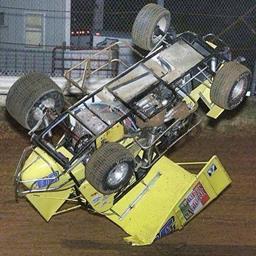

11/27/2014
Miniakota Micro Sprint Series
2015 Safety updates.
Safety belts,
Once a product is passed, the manufacturer installs SFI certification tags on the belts which display the date of manufacture. The purpose of the dated certification tags is to enable drivers and race officials to easily determine when the belts reach their 2-year life span. One of the most important requirements of the specification states that the useful life of the webbing in the straps of the restraint assembly shall not exceed two years and they must be replaced at or before that time. Only the original manufacturer can reweb an assembly prior to recertifying. Any driver with belts older then 2 years will be given a 1 week grace period to replace his belts. Each competitor is the solely responsible of for the effectiveness and proper installation, per the manufacturer’s specifications, of personal safety equipment and determining it to be adequate for competition at every event. Each competi- tor is expected to investigate and educate themselves for continuing improve- ment regarding their own personal safety equipment.
Seats
A.) Aluminum and/or carbon fiber-type seats will be permitted. All seats must be mounted to the frame as required by the seat and chassis manufacturer. Effective February 1, 2015 all cars must be equipped with an approved driver’s seat.
Only the following seats have currently been approved for competition, they must be labeled or identifiable.
a. Butlerbuilt –
b. The Joie of Seating
c. Richardson
d. Fiberworks –
e. Kirkey –
f. Ultrashield –
g. RaceTech Sprint
The approved driver’s seats may be revised from time-to-time with additional approvals at the boards discretioin.
A right side head restraint net and/or support is suggeseted. All head restraint nets should be equipped with quick release mechanisms.
Helmets
A.) All drivers will be required to wear a full-face helmet with a minimum safety rating of FIA 8860-2004, FIA 8860-2010, Snell SA 2005, Snell SA 2010, Snell SAH 2010 and/or a valid SFI 31.1/2005 label.
B.) It is strongly recommended that helmets should have the Eject ™ helmet removal system installed as per the manufacturer’s instructions.
Other RECOMMENDED safety options.
A.) No sharp and/or protruding edges in and around the cockpit.
B.) Windshield screens should be a minimum thickness of 0.090 inch and should be securely fastened to the roll cage.
C.) At all times during an event including practice, qualifying and competition (ex- cluding starting the car for engine warm-up) drivers should wear an SFI-approved head and neck restraint device/system that is properly mounted and connected per the manufacturer’s instructions. The device should meet SFI 38.1 specifica- tions and display a valid SFI 38.1 label.
D.) Arm restraints are recommended and must be connected and used as in- structed by the manufacturer.
E.) Only SFI flame retardant seat, roll bar, knee and steering pads and/or pad- ding should be utilized.
SEAT BELTS Essential to Driver Safety
by Jennifer M. Faye
– The primary goal of any race car driver is to be the best and cross the finish line first. This is achieved by putting long hours of hard work into the engine and tweaking the chassis just right. A lot of thought goes into shaving every fraction of a second off lap time in order to gain even the slightest advantage over competitors.
Hopefully just as much thought goes into driver safety equipment as into the engine. Using quality safety equipment can help a driver get to the finish line in one piece as well as first.
An integral part of safety equipment is the driver restraint assembly, or seat belts, to keep the driver inside the roll cage where the least amount of injury will occur in a crash.
The Anatomy of a Seat Belt
A restraint assembly consists of several components, each with a specific function. The shoulder harness is a belt assembly, one strap for each shoulder, intended to restrain movement of the upper torso and shoulder regions. An optional cross strap across the chest can be used to hold the shoulder harness together. The lap belt restrains movement of the pelvis and the anti-submarine strap prevents the pelvis from slipping forward from under the lap belt in the event of an accident.
The buckle which attaches the belts together should have a quick and easy release mechanism in the case of an emergency situation. There are three types of buckles to choose from: latch/lever, turn/push, and cam lock. All three can be opened in 1 or 2 motions.
A restraint assembly also utilizes two types of hardware. The adjustment hardware is used to alter the length of the individual straps to fit the driver. Mounting hardware secures each strap to the vehicle.
SFI Helps Maintain Quality Assurance in Seat Belt Performance
The purchase of belts should be based on more important criteria than whether or not the color matches the car. One way to tell if one manufacturer’s restraint assembly is more reliable than another’s is to look for belts that are certified to meet performance specifications. Manufacturers whose products pass the standard laboratory tests participate in the SFI Foundation, Inc.’s certification program.
What is SFI Foundation, Inc. and what do they do? SFI is a non-profit organization established to issue and administer standards for all kinds of specialty/performance automotive and racing equipment. Manufacturers of equipment are the primary users of SFI standards. Some standards are adopted as part of the rules of race sanctioning bodies. Ultimately, the consumer benefits from the program because it establishes recognized levels of performance or quality for a product such as driver restraint assemblies.
The specifications are created through a committee process. Technical committees are comprised of individuals from all facets of the industry who provide a comprehensive cross-section of knowledge. Such diverse expertise and open participation is the means by which standards are fairly established.
Participation in the program is purely voluntary, so this does not mean that all manufacturers not in the program produce inferior belts. Their restraint assemblies may be just as good as one that is certified, but they merely choose not to participate in the SFI program. However, to ensure quality belts, it would be a good idea to look for the SFI label.
The standard that applies to safety belts is SFI Specification 16.1. The spec defines a driver restraint assembly and outlines basic design dimensions and requirements. It also explains the testing procedures in detail and how to interpret the test results to determine if the product meets the required criteria and thus passes the test.
Once a product is passed, the manufacturer installs SFI certification tags on the belts which display the date of manufacture. The purpose of the dated certification tags is to enable drivers and race officials to easily determine when the belts reach their 2-year life span. One of the most important requirements of the specification states that the useful life of the webbing in the straps of the restraint assembly shall not exceed two years and they must be replaced at or before that time. Only the original manufacturer can reweb an assembly prior to recertifying.
Seat Belts Should be Inspected and Recertified Every Two Years
Restraints must be maintained, inspected, and replaced or rewebbed every two years because they degenerate from exposure to the elements and over time. Prolonged exposure of seat belt webbing and thread to sunlight can cause degradation of the fibers and loss of restraint integrity.
The rate at which the breaking strength of the webbing decreases with outdoor exposure is illustrated in the graph below. The webbing used in motorsports restraints is typically made with DuPont Nylon 6-6 or a similar product. According to the data, the webbing loses about half of its strength in one year.
With this kind of rapid deterioration, it is obvious why replacing the webbing every two years is essential to driver safety. Old and weakened belts could easily snap under the loads imposed upon them in an accident situation. Failure to properly restrain the driver in a crash would have devastating consequences.
Proper Installation is Important
The effectiveness of a restraint assembly is also influenced by how its installation. It is important that the belts pull from a straight angle against the hardware. The assembly should be installed so that the straps do not rub against any surface that can cause the webbing to fray. The anchoring mechanisms should also periodically be checked so that they don’t become loose or weakened.
Proper installation of the restraint assembly also means achieving the correct fit to the driver. SFI has published a Seatbelt Installation Guide for motorsports vehicles with upright seating. This guide can be used to help determine the optimum installation angles for lap belts, shoulder belts, and crotch belts. You can download the guide by clicking here: SFI Seatbelt Installation Guide.
Always follow the installation instructions provided by the seat belt manufacturer, as well as sanctioning body rules. Also, the necessity of replacing or rewebbing seat belts every two years cannot be more important.
As cars become more advanced and consequently go faster, everything possible must be done to make the racing experience safe as well as fun. Failure to do so can cause serious injury, or worse. If there is anything that can be learned from the sport of racing, it’s that anything is possible, and taking the attitude that “it won’t happen to me” is risky, because it can and does happen.
Submitted By: Wade Huisman





